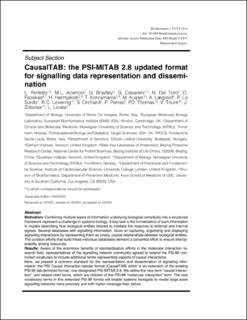| dc.contributor.author | Perfetto, Livia | |
| dc.contributor.author | Acencio, Marcio Luis | |
| dc.contributor.author | Bradley, Glyn | |
| dc.contributor.author | Cesareni, Gianni | |
| dc.contributor.author | del Toro, Noemi | |
| dc.contributor.author | Fazekas, David | |
| dc.contributor.author | Hermjakob, Henning | |
| dc.contributor.author | Korcsmaros, Tamas | |
| dc.contributor.author | Kuiper, Martin | |
| dc.contributor.author | Lægreid, Astrid | |
| dc.contributor.author | Lo Surdo, Prisca | |
| dc.contributor.author | Lovering, Ruth C. | |
| dc.contributor.author | Orchard, Sandra | |
| dc.contributor.author | Porras, Pablo | |
| dc.contributor.author | Thomas, Paul | |
| dc.contributor.author | Touré, Vasundra | |
| dc.contributor.author | Zobolas, John | |
| dc.contributor.author | Licata, Luana | |
| dc.date.accessioned | 2020-05-18T07:00:27Z | |
| dc.date.available | 2020-05-18T07:00:27Z | |
| dc.date.created | 2019-02-25T14:52:43Z | |
| dc.date.issued | 2019 | |
| dc.identifier.citation | Bioinformatics. 2019, 35 (19), 3779-3785. | en_US |
| dc.identifier.issn | 1367-4803 | |
| dc.identifier.uri | https://hdl.handle.net/11250/2654693 | |
| dc.description.abstract | Motivation
Combining multiple layers of information underlying biological complexity into a structured framework represent a challenge in systems biology. A key task is the formalization of such information in models describing how biological entities interact to mediate the response to external and internal signals. Several databases with signalling information, focus on capturing, organizing and displaying signalling interactions by representing them as binary, causal relationships between biological entities. The curation efforts that build these individual databases demand a concerted effort to ensure interoperability among resources.
Results
Aware of the enormous benefits of standardization efforts in the molecular interaction research field, representatives of the signalling network community agreed to extend the PSI-MI controlled vocabulary to include additional terms representing aspects of causal interactions. Here, we present a common standard for the representation and dissemination of signalling information: the PSI Causal Interaction tabular format (CausalTAB) which is an extension of the existing PSI-MI tab-delimited format, now designated PSI-MITAB 2.8. We define the new term ‘causal interaction’, and related child terms, which are children of the PSI-MI ‘molecular interaction’ term. The new vocabulary terms in this extended PSI-MI format will enable systems biologists to model large-scale signalling networks more precisely and with higher coverage than before.
Availability and implementation
PSI-MITAB 2.8 format and the new reference implementation of PSICQUIC are available online (https://psicquic.github.io/ and https://psicquic.github.io/MITAB28Format.html).
Supplementary information
Supplementary data are available at Bioinformatics online | en_US |
| dc.language.iso | eng | en_US |
| dc.publisher | Oxford University Press (OUP) | en_US |
| dc.title | CausalTAB: the PSI-MITAB 2.8 updated format for signalling data representation and dissemination | en_US |
| dc.type | Peer reviewed | en_US |
| dc.type | Journal article | en_US |
| dc.description.version | acceptedVersion | en_US |
| dc.source.pagenumber | 3779-3785 | en_US |
| dc.source.volume | 35 | en_US |
| dc.source.journal | Bioinformatics | en_US |
| dc.source.issue | 19 | en_US |
| dc.identifier.doi | 10.1093/bioinformatics/btz132 | |
| dc.identifier.cristin | 1680508 | |
| dc.relation.project | Norges forskningsråd: 247727 | en_US |
| dc.description.localcode | This is a pre-copyedited, author-produced version of an article accepted for publication following peer review. The version of record is available online at: https://doi.org/10.1093/bioinformatics/btz132 | en_US |
| cristin.ispublished | true | |
| cristin.fulltext | original | |
| cristin.fulltext | postprint | |
| cristin.qualitycode | 2 | |
